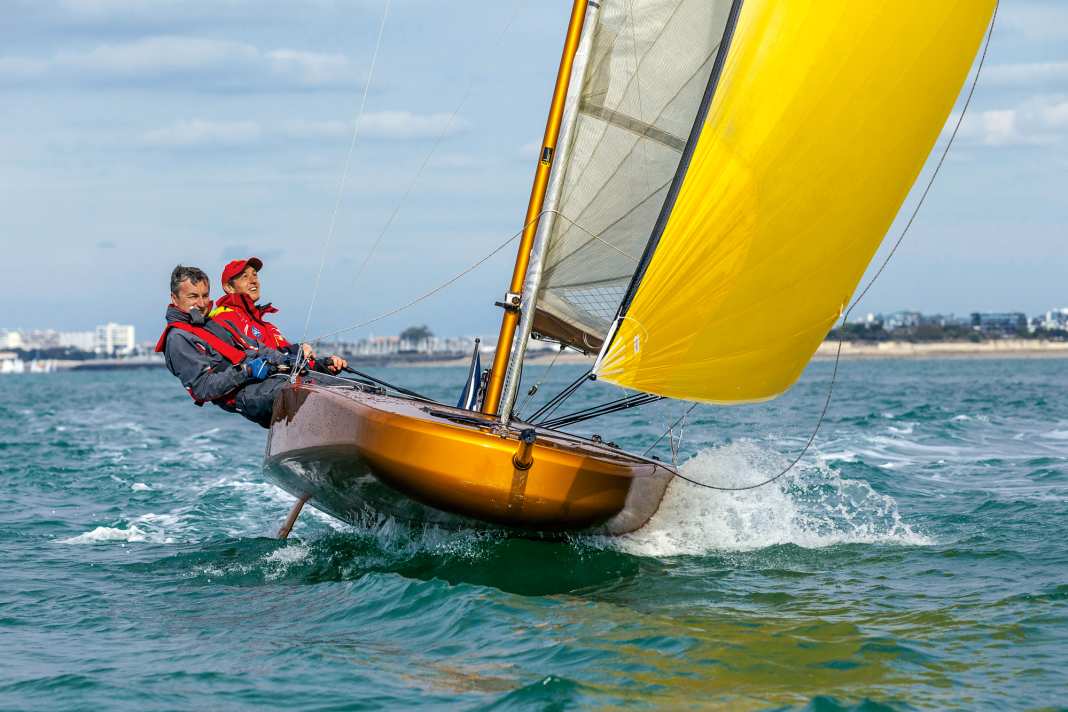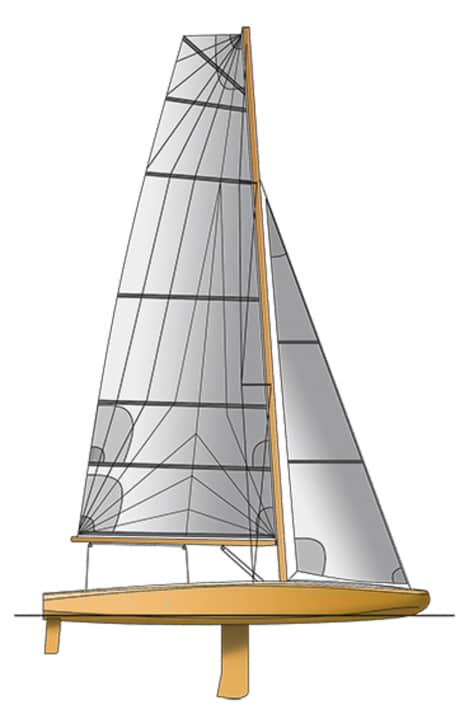





Sometimes it's a good thing when something goes completely wrong. At least that was the story behind the creation of the Scow FR 18, which went like this: "A few years ago, an owner who had already bought two boats from me begged me to build him something like this," explains Franck Roy, head of Construction Navale Franck Roy, a shipyard named after him and highly respected in France.
Also interesting:
The Ufo-like boat with its extremely flat hull and flat bow does not really fit into his traditionally inspired model programme, which includes elegant daysailers as well as replicas of Herreshoff designs. But Monsieur didn't let up, and the order probably appealed to Roy himself so much that he finally got to work.
When it was finished, the enthusiasm knew no bounds. Although as exotic as a unicorn in a herd of buffalo, so completely unusual in shape and proportions, and with a metallic copper-coloured paintwork instead of the usual white, the Scow won the hearts of many sailors at boat shows straight away. Even the jury of Europe's Yacht of the Year paid tribute to the construction number 1 and nominated her straight away for the Special Boat category in 2016.
The scow was created by mistake
Only her owner, who had wanted her so much, didn't really warm to her. Of course, this was not due to her appearance. Rather, the boat, which had only been created at his insistence, seemed too sporty to him after the first trial runs. A peculiar twist: the Scow turned out to be a bad buy for the very man whose initiative had led to its development.
Nevertheless, its genesis can also be seen as a stroke of luck. Otherwise, Franck Roy and his boat builders would probably never have tackled the unique design with the endearingly smiling bow section. And that would have been a shame, to say the least.
Scows are well established, even if they seem unfamiliar to many in this country. They have been an active racing class on America's large inland lakes for more than a hundred years. Only recently have they started to appear on this side of the Atlantic. Quant Boats, for example, has caused a furore with a scow on foils. Mention should also be made of the E-Scow from Melges. However, to speak of a trend would be an exaggeration.
The flat bow, probably the most characteristic feature of the flounder, has also become increasingly popular outside the racing dinghy scene. David Raison was the first to recognise the potential of this hull shape. His victory in the 2011 Mini-Transat race on "TeamWork" made the design principle known to a wider public - and at the same time caused great controversy due to its aesthetics, which took some getting used to. Nonetheless, the wide-mouth frog look has become established. In the meantime, the first production Mini 6.50s have been built in this way, and the Class 40 is also moving in this direction.
What speaks in favour of this type of construction is its high dimensional stability and the large buoyancy in the foredeck, which prevents the boat from drifting out of position. It also minimises the risk of "plugs" on fast room sheet courses. However, it was not only these advantages that prompted Franck Roy to develop the modern version of a scow. Rather, he has always been committed to the art of building contemporary sailing boats with lines characterised by classic models.
Relief against arbitrariness
The 18-foot vessel, which is half dinghy, half centreboard, looks like a sailing sandpit from afar - the freeboard is so flat, the cockpit so square. The boat was designed by Mortain & Mavrikios, a French-Greek design team based in nearby La Rochelle, who are happy to take on such special commissions.
Designed for sheltered coastal areas and inland lakes, the Scow FR 18 has a comparatively powerful rig with a wide, flared main and a slender self-tacking jib that is similar to a foresail. Even in the standard configuration with aluminium mast, it achieves the sail carrying capacity of a racing yacht: 6.6; most sports boats have less cloth in relation to their weight. The test boat with carbon spars and larger foil sails even achieved a value of 7.1 - no wonder that the first owner gained respect.
These data and the associated propulsive power are in flirtatious contrast to the delicacy of the boat's hull. Even more than the crack and images suggest, the creature in the flesh is enchanting with its touchingly delicate, slender form. It does not lie in the water, it seems to float on it.
And although the shape might appear rather clumsy due to the lack of tapering at the ends, it has a special appeal. The hull derives a subtle tension from the negative deck curve and the opposing chine edges. This is reinforced by the delicately modelled details of the construction, such as the bevelled edges of the coaming and the slightly recessed cover of the transom, under which there is space for mooring lines and fenders. Even the letters of the boat's name emphasise the special nature of the design. They are not punched out of foil, but individually cast from bronze and chrome-plated - a relief against arbitrariness.
Wave does not like the Scow 18 FR
When boarding, the pretty one proves to be surprisingly unpretentious. She doesn't sag when you step onto the foredeck and hardly leans to one side when you go aft into the cockpit. It is the first quiet wow effect that the Scow FR 18 conveys. Although her length-to-width ratio is quite moderate, she benefits from the enormous dimensional stability of her box-like hull, which is plumb at all ends.
Franck Roy also offers a small electric drive on request. This does not appear to be absolutely necessary. During the test, the little boat, which weighs only 280 kilograms, could be moored and cast off under sail without any problems. It actually handles more like a dinghy, but at the same time has the stability reserves of a small yacht.
Thanks to well-arranged lines and fittings, the Scow can be handled safely single-handed. The fully battened main is a little bulky in the rig. On the other hand, the jib rolls out by itself. Even the gennaker is quickly set and almost as quickly retrieved; it is stored in a bag under the foredeck and is operated from the cockpit. A large, funnel-like hatch next to the forestay makes manoeuvres easier. However, it also ensures that small tides run aft through the cockpit on upwind and downwind courses.
The Scow 18 FR doesn't like waves anyway. She acknowledges even 30 centimetres of wind sea with occasional pitching and bucking. On the construction number 1 that we sailed, this peculiarity could not even be eliminated by extreme weight trim to leeward and aft. Franck Roy therefore modified the design significantly from the second boat onwards. The pronounced U-frame is now softer at the stern in particular, which has a noticeably positive effect, as colleagues from France report. If the crew slides aft, the flat bow now lifts significantly; it moves more over than against the wave.
Scow FR 18 can be addictive
And how it sails! In 12 to 15 knots of wind, the flounder can still be sailed easily under full sail, provided you make use of the well-placed outhaul harnesses. The Scow then starts planing under mainsail and self-tacking jib. With a gennaker, this is even possible from around 8 knots of wind.
It's a magical moment. Suddenly it becomes completely calm. The water separates from the transom without a whirlpool, the rudders mounted firmly under the hull react even more directly. A fascinating equilibrium that can be addictive, precisely because everything seems to be effortless, even weightless.
Of course, you can also challenge, drive and push the Scow. And it responds to this with even more speed without grumbling or falling over. But it's actually far too good, too elegant and too sensitive for that. It's just as much fun sitting in the cockpit, catching the last breath of wind and gliding along the shore with her on an after-work trip.
Technical data of the Scow FR 18

- Designer: Mortain & Mavrikios
- Torso length: 5,50 m
- Width: 1,92 m
- Draught (max./min.): 1,10/0,44 m
- Weight: 280 kg
- Ballast/proportion: 60 kg/21 %
- sail area: 18,8 m²
This article was first published in 2019 and has been revised for this online version.

